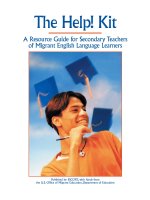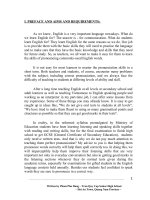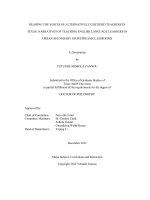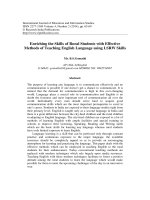Hearing the voices of alternatively certified teachers in Texas: Narratives of teaching English language learners in urban secondary mainstream classrooms
Bạn đang xem bản rút gọn của tài liệu. Xem và tải ngay bản đầy đủ của tài liệu tại đây (500.73 KB, 9 trang )
HEARING THE VOICES OF ALTERNATIVELY CERTIFIED TEACHERS IN
TEXAS: NARRATIVES OF TEACHING ENGLISH LANGUAGE LEARNERS IN
URBAN SECONDARY MAINSTREAM CLASSROOMS
A Dissertation
by
YETUNDE MOBOLA ZANNOU
Submitted to the Office of Graduate Studies of
Texas A&M University
in partial fulfillment of the requirements for the degree of
DOCTOR OF PHILOSOPHY
Approved by:
Chair of Committee,
Committee Members,
Head of Department,
Norvella Carter
M. Carolyn Clark
Zohreh Eslami
Gwendolyn Webb-Hasan
Yeping Li
December 2012
Major Subject: Curriculum and Instruction
Copyright 2012 Yetunde Zannou
UMI Number: 3537064
All rights reserved
INFORMATION TO ALL USERS
The quality of this reproduction is dependent upon the quality of the copy submitted.
In the unlikely event that the author did not send a complete manuscript
and there are missing pages, these will be noted. Also, if material had to be removed,
a note will indicate the deletion.
UMI 3537064
Published by ProQuest LLC (2013). Copyright in the Dissertation held by the Author.
Microform Edition © ProQuest LLC.
All rights reserved. This work is protected against
unauthorized copying under Title 17, United States Code
ProQuest LLC.
789 East Eisenhower Parkway
P.O. Box 1346
Ann Arbor, MI 48106 - 1346
ABSTRACT
In Texas, nearly half of all new teachers are alternatively certified (AC) whilst
English language learners (ELL) are over one-third of the public school population in
some districts. As this trend continues, the likelihood that AC teachers will teach ELLs
increases and alters what Texas teachers must know upon entering the classroom. This
research explores teacher knowledge and beliefs about teaching ELLs through
constructivist and narrative lenses. Four AC science teachers in two diverse school
districts participated in in-depth interviews and reflective interviews following
classroom observations to answer the research questions: (1) how do AC teachers
describe and interpret their acts of teaching ELLs in mainstream classrooms; and (2)
how do AC teachers describe and interpret their learning to teach ELLs in mainstream
classrooms. Data were transcribed and analyzed using thematic narrative methods.
This study found that participants saw ELL instruction as: (1) “just good
teaching” strategies, (2) consisting primarily of cultural awareness and consideration for
student comfort, and (3) less necessary in science where all students must learn the
language. The most experienced teacher was the only participant to reference specific
linguistic knowledge in describing ELL instruction. Many of the teachers described their
work with ELL students as giving them an opportunity to improve their lives, which was
consistent with their overall teaching philosophy and reason for entering the profession.
Participant narratives about learning to teach ELLs described personal experience
and person-to-person discussions as primary resources of knowledge. District support
was generally described as unhelpful or incomplete. Participants portrayed their AC
ii
program as helpful in preparing them to work with ELL students, but everyone desired
more relevant information from the program and more grade-appropriate strategies from
the district.
Participant narratives reveal AC teachers needed a pragmatic and less theoretical
understanding of diversity during pre-service training. Participant tendency to draw
upon “common sense”, affective, and practical strategies in teaching ELL students in
lieu of the state-mandated English language proficiency standards (ELPS) suggests AC
programs should have teachers articulate and discuss their beliefs about ELL instruction
in order to provide training targeted towards misconceptions about language
development, particularly in science.
iii
DEDICATION
To the heroes of faith—past, present, and future.
iv
ACKNOWLEDGEMENTS
With man this is impossible, but with God all things are possible.
Matthew 19:26
For me, “this” is more than about finishing degree requirements; “this” is about
becoming someone new through the process. For that lasting difference and more to
come I thank my God, my Heavenly Father, my Lord. Without You, I would not be
possible. You are my provider and my resource.
This is the culmination of a journey, which I have had the honor to share with so
many people. I would like to thank my committee chair and advisor, Dr. Norvella Carter,
for seeing more in me than I sometimes knew was there. I am proud to be your
colleague. To Dr. Chance Lewis, you are such an encouragement, teaching more with
your actions than could be spoken with words. To Dr. Carolyn Clark, thank you for
making time for me and truly fostering my sense of scholarly competence. To Dr.
Zohreh Eslami, thank you for your willingness to take a chance on me. I always valued
your honest feedback on my early ideas and know I am stronger as a result. To Dr.
Webb-Hasan, thank you for all of your support throughout my doctoral program. I can
only recall taking one class with you but the memories of all you taught me about just
being will remain with me forever. Committee, thank you for the seeds you deposited in
me during this process. In time, they blossomed and saw me through to the completion
of this project.
v
I would like to thank the teachers who participated in this study. Thank you for
giving of your time and yourselves as an expression of your belief in this research. I am
forever grateful to you.
To my biggest cheerleader ever, my mom Kudi Smith! Words cannot express
how much your love and support have meant to me throughout this 4-year journey. I can
honestly say I would not have been able to complete this without you, without the peace
of mind sharing life with you has brought me. I love you dearly mom. Thank you. To my
brother Mide and my nieces Folasade and Adenike, thank you for your support and
understanding why I sometimes couldn’t be with you though my heart longed to be. I am
so happy to celebrate this achievement with you.
To Genesis and my Congress-WBN family, what can I say? You have been my
backbone, helping me to stand straight, not shrink back, and finish well. I am so glad to
be journeying with you all—for now and for always. My tribe!
vi
TABLE OF CONTENTS
Page
ABSTRACT ..............................................................................................................
ii
DEDICATION ..........................................................................................................
iv
ACKNOWLEDGEMENTS ......................................................................................
v
TABLE OF CONTENTS ..........................................................................................
vii
CHAPTER
I
II
III
INTRODUCTION ................................................................................
1
Background of the Study ................................................................
Personal Story ................................................................................
Making Meaning: A Constructivist Approach ...............................
Statement of the Problem ...............................................................
Purpose of the Study ......................................................................
Significance of the Study ...............................................................
Research Questions ........................................................................
Definitions ......................................................................................
Organization of the Study ..............................................................
1
12
16
19
21
22
24
25
28
LITERATURE REVIEW .....................................................................
29
Alternatively Certified Teachers ....................................................
Mainstream Teachers of ELLs .......................................................
Just Good Teaching and ELL Instruction ......................................
ELL Instructional Standards...........................................................
Summary ........................................................................................
30
34
41
46
52
METHODOLOGY ...............................................................................
54
Narrative Inquiry ............................................................................
Research Context ............................................................................
Purposeful Sample ..........................................................................
Instrumentation...............................................................................
Data Collection ...............................................................................
Researcher’s Role ...........................................................................
Participants .....................................................................................
Data Analysis .................................................................................
54
57
61
64
65
69
72
73
vii
CHAPTER
IV
V
Page
Trustworthiness and Credibility .....................................................
Summary ........................................................................................
81
82
FINDINGS ...........................................................................................
84
Jane’s Story ....................................................................................
Maya’s Story ..................................................................................
Nina’s Story....................................................................................
Naomi’s Story ................................................................................
Summary ........................................................................................
85
109
139
169
199
DISCUSSION, CONCLUSION, AND
RECOMMENDATIONS FOR FUTURE RESEARCH ....................... 201
Discussion .....................................................................................
Conclusion ......................................................................................
Recommendations ..........................................................................
Implications for Future Research ...................................................
201
208
209
211
REFERENCES .......................................................................................................... 213
APPENDIX A............................................................................................................ 229
viii









